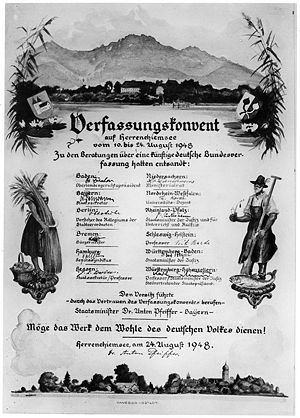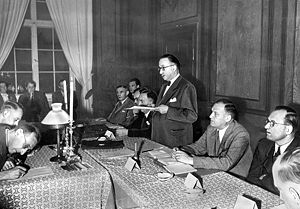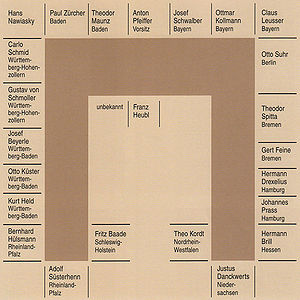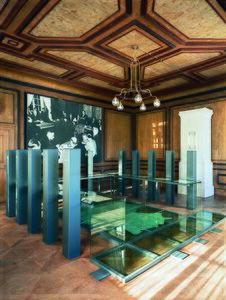The Constitutional Convention at Herrenchiemsee laid the crucial groundwork for a German constitution over the course of two weeks. It was convened by the prime ministers of the Western occupation zone states in August 1948. The convention, initially meant to be merely an advisory body consisting of some 30 experts from the fields of jurisprudence and politics, did such a convincing job that the later Constituent Assembly in Bonn built on its preparatory work. The convention drafted a constitution, which eventually became the basis for devising a Grundgesetz (Basic Law) for the Federal Republic of Germany.
Convening and composition of the convention

At the London Conference in spring 1948 (February 23rd to June 2nd 1948), the Western Allies USA, Great Britain, France as well as representatives of neighbouring states Belgium, the Netherlands and Luxembourg decided in favour of the foundation of a new Western state on German soil. The Allied military governors presented the conference’s results to the West German Minister-Presidents on 1 July 1948 in form of the Frankfurt documents. This gave the prime ministers the mandate to found a state, and therefore to draft a West German constitution. The mandate given to the federal states' heads of government was the logical consequence of the fact that these states and their parliaments, elected by the people, were the only manifestations of state and particularly German organisation at that time, preceding the enactment of the Grundgesetz (Basic Law). The prime ministers decided to convene a panel of experts to prepare a draft constitution in preparation for the Constituent Assembly.
The Bavarian Minister President Hans Ehard (CSU, 1887-1980, Minister-President 1946-1954 and 1960-1962) issued an invitation to the Herreninsel island in the Chiemsee lake; according to his own statement "in an effort to intensify Bavaria's influence on the shaping of the future constitution as much as possible". From August 10th to August 23th 1948, around 30 experts from the fields of law and politics met in the Old Palace on Herrenchiemsee. All the West German states were represented; Berlin was also able to participate in an advisory capacity through Otto Suhr (SPD, 1894-1957). The core of the convention was formed by eleven advisors with voting rights, sent by their respective Minister-Presidents, among them Josef Schwalber (CSU, 1902-1969) for Bavaria, Adolf Süsterhenn (CDU, 1905-1974) for Rhineland-Palatinate and Carlo Schmid (SPD, 1896-1979) for Württemberg-Hohenzollern. In addition, there were about 20 non-voting advisors, including Hans Nawiasky (1880-1961), Theodor Maunz (CSU, 1901-1993) and Otto Küster (1907–1989). The Bavarian State Secretary and Head of the State Chancellery State Chancellery Anton Pfeiffer (CSU, 1888-1957) was heading the convention.
How the Constitutional Convention worked


With the Herreninsel in the Chiemsee lake, a conference venue was chosen that was far removed from everyday political life and resembled a refuge. However, numerous protocols, some of them written in shorthand, some of them just summarising, allow us to understand many of the decisions made in seclusion. Still, existing documents on joint excursions, walks around the island, dinners and dances, "special sessions" in individual hotel rooms, as well as the diary entries by Hermann Louis Brill (1895-1959) and Josef Beyerle (1881-1963) also show that many discussions took place outside of the protocol.
The contents of the Constitutional Conventions work were based on a "Bavarian Draft" (prepared by Schwalber, Claus Leusser [1909-1966], Heinrich Kneuer [1887-1959] and Hans Nawiasky), the "Thoughts on the Basic Law" by Ottmar Kollmann (1886-1969), the federal state constitutions and in particular the Weimar Constitution. The Weimar Constitutions serious constructional errors, above all the possibility of gradual elimination of the constitution through constitutional transgressions, were to be avoided and their achievements, especially the comprehensive catalogue of fundamental rights, were to be built on.
In order to improve its working capacity in the face of a tight time schedule, the Constitutional Convention was divided into three subcommittees:
- Subcommittee I: Issues of principle concerning preamble, naming, territory and constitutional jurisdiction
- Subcommittee II: Issues of competence in legislation, jurisdiction and administration, financial constitution issues
- Subcommittee III: Organisational issues relating to the structure, organisation and functioning of state bodies
The substantive work was largely carried out in these subcommittees. The proportion of non-voting members was exceptionally high on subcommittee II and III. The subcommittees' final reports were discussed in the plenum, sometimes at length. The final version of the Herrenchiemsee draft constitution was obtained through the work of an editorial commission appointed by Anton Pfeiffer and led by Bavarian delegates (Otto Küster, Leusser, Klaus-Berto von Doemming, Gustav von Schmoller [1907-1991], Kurt Held [1908-2000], Ottmar Kollmann [1886-1969]).
A comparison of the subcommittees' final reports with the final version (the draft constitution from Herrenchiemsee) shows that there are deviations, and that some standards were ultimately formulated in accordance with Bavarian ideas.
The outcome of the Constitutional Convention
The Constitutional Convention at Herrenchiemsee was not a constituent assembly but a committee of experts, which was to carry out preparatory work for the Parliamentary Council in Bonn (North Rhine-Westphalia). Therefore, at the end of the discussions, there was not a finished constitution but rather a draft of one. Nevertheless, the final report of the Constitutional Convention at Herrenchiemsee contains - in addition to a legal policy treatise on fundamental issues regarding the future state structure – a complete constitutional text with 149 articles. Where the Constitutional Convention was unable to agree on a version, the relevant versions were listed next to each other.
Differences of opinion arose primarily on issues pertaining to the relationship between the Federal Government and the states. Although there was agreement that a "states" chamber should be set up opposite the Parliament, the form it should take was disputed. Bavaria's representatives in particular spoke out in favour of a Bundesrat (Federal Council) solution: the Bundesrat should be composed of members of the state governments, the approval of both houses of parliament should be required for the adoption of a law, the Bundesrat should not have equal rights to the Bundestag (Federal Parliament) when forming a government – only in the event of the Bundestag not proposing a government within one month should the right to propose a government be transferred to the Bundesrat.
On the other hand, there was the Senate model: Louis Brill notably pleaded for a Senate, to be elected first by the state parliaments and later by the people, and for it to be given a veto right in the legislative process, which could only be exceeded by a two-thirds majority in the Bundestag. This Senate should not be involved in the formation of the government, but it should be granted the sole right to control the accounts.
Among the convention's "undisputed main ideas" were: the dependence of the government on parliament, the neutral power of the head of state, who is separate from the government, and the immutability of the freiheitliche und demokratische Grundordnung (free and democratic basic order); that the right to issue emergency decrees should lie with the state chamber and not with the head of state; legislation, administration, justice, financial sovereignty and the obligation for financing should categorically lie with the states.
The reception of the Herrenchiemsee draft in the Parliamentary Council
The prime ministers handed over the Herrenchiemsee draft to the Parliamentary Council as a non-binding working basis on 1 September 1948, emphasizing that the Constitutional Convention's draft was not a government bill. There was accordingly no representative of the Ministerpräsidentenkonferenz (Conference of Federal State Minister-Presidents, who could have represented the draft before the Parliamentary Council.
Nonetheless, the Herrenchiemsee draft constitution became the authoritative template for the Parliamentary Council's work. One reason for this is that the Herrenchiemsee draft was a complete draft constitution and did not consist of mere proposals on individual issues. In addition, Herrenchiemsee's draft came from a body that was non-partisan and supra regional, and which was not turned into a party political pawn. Finally, there was a continuity of personnel from Herrenchiemsee to Bonn, which was in some way a guarantee for the adoption of the draft: a total of six members of the Constitutional Convention were also represented on the Parliamentary Council: Carlo Schmid, Adolf Süsterhenn (1905-1974), Josef Schwalber, Anton Pfeiffer, Otto Suhr and Hermann Fecht (BCSV, CDU, 1880-1952).
A comparison of the Basic Law for the Federal Republic of Germany as amended on 23 May 1949 with the Herrenchiemsee draft shows that the structure of the texts is almost identical. The fundamental rights form the first part of the constitution and are almost entirely the same as the Herrenchiemsee draft in their content and wording. The sections on the state organisational law were also adopted largely and often literally.
Contrary to the Herrenchiemsee draft, the Parliamentary Council rejected a referendum for constitutional amendments, as well as the proposed emergency decree law. On the issue of the states' guarantee of continued existence, the unanimity in the Bundesrat proposed by the Constitutional Convention for the amendment of the federal basic order was rejected and the quorum was increased: the Parliamentary Council placed the division of the Federation into states and the fundamental participation of the states in legislation under the guarantee of eternity in Article 79 Section 3. In the issue of the "second chamber", the Parliamentary Council opted for the Bundesrat.
Impact and evaluation of the Constitutional Convention
In August 1948, the Constitutional Convention at Herrenchiemsee drew up a draft constitution for the Parliamentary Council within just two weeks. In terms of content and form, the majority of the Basic Law for the Federal of Germany goes back to the preparatory work of the Constitutional Convention at Herrenchiemsee. Even where the Parliamentary Council took different decisions and found different wordings, the Herrenchiemsee draft was the starting point around which the debates in Bonn revolved.
Members of the Constitutional Convention in particular referred back to the draft time and again and mentioned the arguments put forward in Herrenchiemsee. The Herrenchiemsee Convention therefore undoubtedly deserves a place of honour in the history of the origin of the Basic Law.
-
Conference room in Herrenchiemsee Old Palace. A presentation on the history of the Constitutional Convention has been on display in the historic rooms since 1998. The picture shows the old presentation until 2022.(Bayerische Verwaltung der staatlichen Schlösser, Gärten und Seen (Bavarian Administration of State-Owned Palaces, Gardens and Lakes))
-
View of the permanent exhibition 'The Will to Freedom and Democracy. The Constitutional Convention of Herrenchiemsee 1948' (redesigned for the 75th anniversary in 2023), Herrenchiemsee, Old Palace, Museum im Augustiner-Chorherrenstift. (© Bayerische Schlösserverwaltung (Bavarian Palace Administration), Maria Scherf / Andrea Gruber, Munich)
On the Herreninsel in the Chiemsee lake, the rooms where the foundation stones for the German constitution were laid can still be seen today; the exhibition displaying numerous documents illustrates the work of the Constitutional Convention. A look at the history of the origin of the Basic Law, which places the content of the constitutional norms in very close relation to their creators, enables a different understanding of the constitution: An understanding that is not bound to the spirit of the times but to the will of the constitutional legislator.
References
- Angela Bauer-Kirsch, Herrenchiemsee. Der Verfassungskonvent von Herrenchiemsee - Wegbereiter des Parlamentarischen Rates, Diss. Online-Ausgabe Bonn 2005.
- Peter Bucher, Einleitung, in: Deutscher Bundestag/Bundesarchiv (Hg.), Der Parlamentarische Rat 1948-1949. Akten und Protokolle. 2. Band: Der Verfassungskonvent auf Herrenchiemsee, bearbeitet von Peter Bucher, München 1981, 7ff.
- Bundesrat (Hg.), 50 Jahre Herrenchiemseer Verfassungskonvent - zur Struktur des Deutschen Föderalismus. Tagungsband zum wissenschaftlichen Symposium vom 19. bis 21. August 1998, Bonn 1999.
- Barbara Fait/Manfred Treml, Auf dem Weg zum Grundgesetz. Verfassungskonvent Herrenchiemsee 1948 (Hefte zur bayerischen Geschichte und Kultur 21), Augsburg 1998.
- Sabine Kurtenacker, Der Einfluss politischer Erfahrungen auf den Verfassungskonvent von Herrenchiemsee. Entwicklung und Bedeutung der Staats- und Verfassungsvorstellungen von Carlo Schmid, Hermann Brill, Anton Pfeiffer und Adolf Süsterhenn, München 2017.
- Peter März/Heinrich Oberreuter (Hg.), Weichenstellung für Deutschland. Der Verfassungskonvent von Herrenchiemsee, München 1999.
- Martin Schumacher (Hg.), M.d.B. - Volksvertretung im Wiederaufbau 1946-1961. Bundestagskandidaten und Mitglieder der westzonalen Vorparlamente. Eine biographische Dokumentation, Düsseldorf 2000.
- Sebastian Ullrich, Der Weimar-Komplex. Das Scheitern der ersten deutschen Demokratie und die politische Kultur der frühen Bundesrepublik (Hamburger Beiträge zur Sozial- und Zeitgeschichte 45), Göttingen 2009.
- Petra Weber, Carlo Schmid (1896–1979). Eine Biographie, München 1996.
Sources
- Deutscher Bundestag/Bundesarchiv (Hg.), Der Parlamentarische Rat 1948-1949. Akten und Protokolle. 2. Band: Der Verfassungskonvent auf Herrenchiemsee, bearbeitet von Peter Bucher, Boppard 1981.
Further Research
External Links
Herrenchiemsee-Konvent , Tagung des Ausschusses für Verfassungsfragen auf Herrenchiemsee
Related Articles
- Beziehungen zum Bund
- Bundesrat
- Föderalismus
- Länderrat des amerikanischen Besatzungsgebietes
- Münchener Ministerpräsidentenkonferenzen
Cite
Angela Kirsch, Constitutional Convention at Herrenchiemsee, 10-23 August 1948, published 16 June 2014, English version published 21 February 2024; in: Historisches Lexikon Bayerns, URL: <https://www.historisches-lexikon-bayerns.de/Lexikon/EN:Constitutional_Convention_at_Herrenchiemsee,_10-23_August_1948> (21.12.2025)


